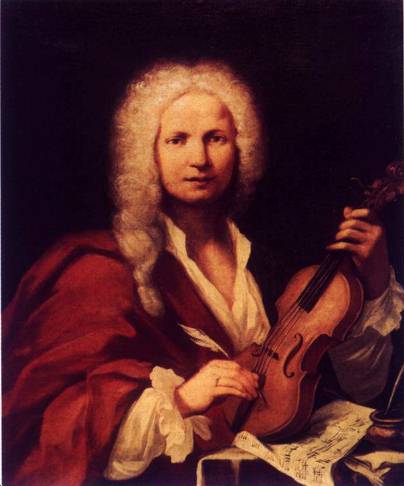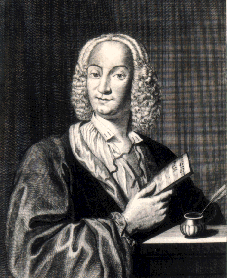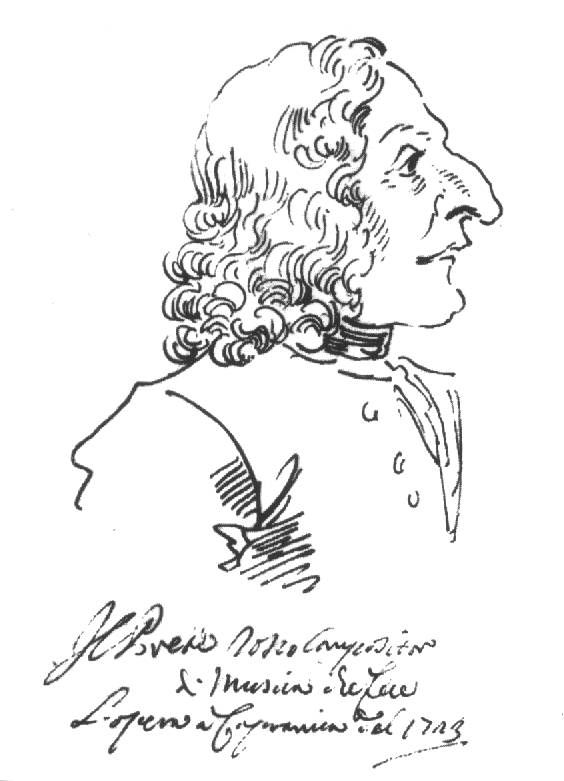| Classical Music
Best Composer Poll
Antonio Vivaldi
Baroque Era
Classical Era
Romantic Era
Composers 1
Composers 2
Composers 3
Composers 4
Composers 5
Guest Book Page
My Ideas
|
|
|
Master Of Colours: Antonio Vivaldi
Born in Venice, 4 March 1678; died in Vienna, 28 July 1741).
He was the son of a professional violinist who played at St. Mark's and may have been involved in operatic management. Vivaldi was trained for the priesthood and ordained in 1703 but soon after his ordination ceased to say Mass. he claimed this was because of his unsure health (he is known to have suffered from chest complaints, possibly asthma or angina). In 1703 he was appointed maestro di violino at the Ospedale della Pieta, one of the Venetian girls' orphanages; he remained there until 1709, and held the post again, 1711-16; he then became maestro de' concerti. Later, when he was away from Venice, he retained his connection with the Pieta (at one period he sent two concertos by post each month). He became maestro di cappella, 1735-8; even after then he supplied concertos and directed performances on special occasions.
Vivaldi's reputation had begun to grow with his first publications: trio sonatas (probably 1703-5), violin sonatas (1709) and especially his 12 concertos L'estro armonico op.3 (1711). These, containing some of his finest concertos, were issued in Amsterdam and widely circulated in northern Europe; this prompted visiting musicians to seek him out in Venice and in some cases commission works from him (notably for the Dresden court). Bach transcribed five op.3 concertos for keyboard, and many German composers imitated his style. He published two further sets of sonatas and seven more of concertos, including La stravaganza op.4 (circa 1712), Il cimento dell'armonia e dell'inventione (circa 1725, including 'The Four Seasons') and La cetra (1727). It is in the concerto that Vivaldi's chief importance lies. He was the first composer to use ritornello form regularly in fast movements, and his use of it became a model; the same is true of his three-movement plan (fast-slow-fast). His methods of securing greater thematic unity were widely copied, especially the integration of solo and ritornello material; his vigorous rhythmic pattems, his violinistic figuration and his use of sequence were also much imitated. Of his circa 550 concertos, circa 350 are for solo instrument (more than 230 for violin); there are circa 40 double concertos, more than 30 for multiple soloists and nearly 60 for orchestra without solo, while more than 20 are chamber concertos for a small group of solo instruments without orchestra (the 'tutti' element is provided by the instmments all playing together). Vivaldi was an enterprising orchestrator, writing several concertos for unusual combinations like viola d'amore and lute, or for ensembles including chalumeaux, clarinets, horns and other rarities. There are also many solo concertos for bassoon, cello, oboe and flute. Some of his concertos are programmatic, for example 'La tempesta di mare' (the title of three concertos). Into this category also fall 'The Four Seasons', with their representation of seasonal activities and conditions accommodated within a standard ritornello form - these are described in the appended sonnets, which he may have written himself.
Vivaldi was also much engaged in vocal music. He wrote a quantity of sacred works, chiefly for the Pieta girls, using a vigorous style in which the influence of the concerto is often marked. He was also involved in opera and spent much time travelling to promote his works. His earliest known opera was given in Vicenza in 1713; later he worked at theatres in Venice, Mantua (1718-20), Rome (probably 1723-5), possibly Vienna and Prague (around 1730), Ferrara (1737), Amsterdam (1738) and possibly Vienna during his last visit. He was by most accounts a difficult man; in 1738 he was forbidden entry to Ferrara ostensibly because of his refusal to say Mass and his relationship with the singer Anna Giraud, a pupil of his with whom he travelled. More than 20 of his operas survive; those that have been revived include music of vitality and imagination as well as more routine items. But Vivaldi's importance lies above all in his concertos, for their boldness and originality and for their central place in the history of concerto form.
|
| |
The Four Seasons
Vivaldi's most famous work is the four seasons. Nowadays since the Vivaldi revival in the middle of the century, the four seasons have become one of the most popular and recorded classical music pieces. If you want to get a start with Vivaldi, the four seasons are a logical and easy place to start. The four seasons are four concertos for solo violin, first violins, second violins, violas, cellos [basses] and continuo (usually played by harpiscord). These concertos are the first four of Vivaldi's opus 8, the trial between harmony and invention. The title is suggestive of an artistic statement, the balance between musical logic and inventive creativity.
The Four Seasons are highly programatic, Vivaldi published poems with the works and even had each line of the poems put where the programatic effect is occuring.
The sonnets:
Spring:
Spring has come, and the brids greet it festivelt with a cheerful song; And with the breath of the gentle breezes spring trickle with a pleasant murmur. Lightening and thunder, elected to announce it, come and cover the air with a black cloak. Once they are quiet, the birds return to their enchanting song. Then on the pleasant, flowering meadow a goatherd with his faithful dog at his side, sleeps to the sweet murmur of the foiliage and plants. To the festive sound of a rustic bagpipe nymphs and shepherds dance under the beloved canopy at the brilliant appearance of spring.
Summer:
Under the harsh season ignited by the sun, man and flock languish, and the pines burn; The cuckoo offers his voice and, soon heard, the young turtledove and goldfinch sing. Zepher (west wind) blows gently, but suddenly Boreas (north wind) offers opposition to his neighbor; and the shepherd boy weeps, because he fears a severe storm in the offing - and his destiny. The repose of his tired limbs is disturbed by the fear of lightning and fiery thunder, and by a furious swarm of flies and wasps. Unfortunately, his fears are justified. The sky thunders and fuminates, and hail flattens the corn and majestic grains.
Autumn:
The peasant celebrates the blissful pleasure of a happy harvest with dances and songs, and glowing liquor of Bacchus, many complete their enjoyment with sleep. The air tempered by pleasure, makes everyone give up dances and songs. It is this season that invites so many to the great enjoyment of a sweet sleep. At dawn the hunters are off to the hunt with horns, rifles and dogs. The wild beast flees, and they follow its trail. Frightened already, and fatigued by the noise of rifles and dogs, wounded, it threatens languidly to flee, but, overcome, it dies.
Winter:
To tremble from the cold in the icy snow, in the harsh breath of a horrid wind; to run, stamping our feet every moment, our teeth chattering in the extreme cold. Before the fire to pass peaceful contented days while the rain outside pours down. To walk on the ice and, at a slow pace for fear of falling, move carefully. To make a bold turn, to slip, to fall down. To go on the ice once more
and run hard until the ice breaks up. To hear the sirocco (warm south wind), boreas, and all the winds at war leave their iron gates: this is winter, but, even so, what joy it brings!
|
 "If acute and rapid tones are evil, Vivaldi has much of the sin to answer for." Charles BURNEY
"If acute and rapid tones are evil, Vivaldi has much of the sin to answer for." Charles BURNEY |
| |
|
 Antonio VIVALDI (1678-1741)
Antonio VIVALDI (1678-1741) |
| |
|
 A drawing of A. Vivaldi by Pier Leone GHEZZI (1723)
A drawing of A. Vivaldi by Pier Leone GHEZZI (1723) |
|
|


